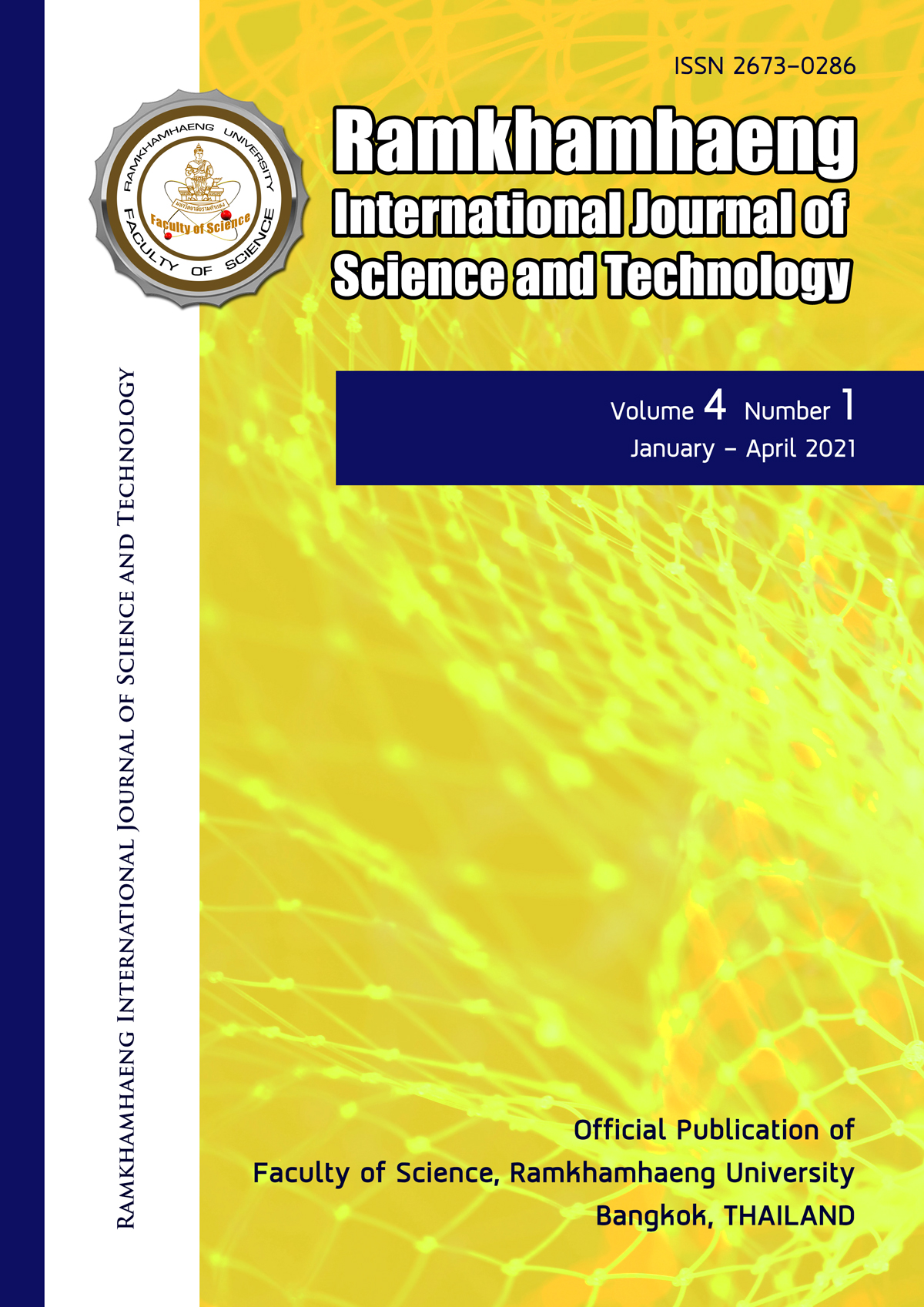Coral community structures on shallow reef flat, reef slope and underwater pinnacles in Mu Ko Chumphon, the Western Gulf of Thailand
Keywords:
Coral Bleaching, Shading, Mortality, Recovery, Gulf of ThailandAbstract
The coral reef ecosystem is the most diverse and productive marine ecosystems in the world. Coral reefs provide high species diversity which enhances a community survival rate when the condition of the environment change. Coral reefs are commonly found widely distributed in depths up to 30m. And various environmental factors drive different community compositions. This study examined coral community structures on shallow reef flat, reef slope and underwater pinnacles in the Western Gulf of Thailand. The field surveys were conducted at three coral reefs, including Ko Mattra, Ko Lawa, and Ko Kula and three underwater pinnacles i.e. Hin Thong Vo, Hin Jen Talay and Hin Ang in Mu Ko Chumphon by using a belt transect method. The results revealed that the percentages of live coral cover at most study sites were relatively high (over 50%). We found high species diversity of corals at the underwater pinnacles. The most dominant coral at all three study sites was Porites lutea. The dominant corals on underwater pinnacles were also Favites spp., Dipsastraea spp. and Diploastrea heliopora. This study highlights the importance of underwater pinnacles in the Gulf of Thailand for their ecosystem services, particularly providing fishery products and incomes from tourism.
References
Bellwood DR, Tebbett SB, Bellwood O, Mihalitsis M, Morais RA, Streit RP, Fulton CJ (2018) The role of the reef flat in coral reef trophodynamics: Past, present, and future. Ecology and evolution. 8(8): 4108–4119.
Brown BE, Dunne RP (2008) Solar radiation modulates bleaching and damage protection in a shallow water coral. Marine Ecology Progress Series. 362: 99–107.
EF Camp, V Schoepf, PJ Mumby, LA Hardtke, R Rodolfo-Metalpa, DJ Smith, DJ Suggett (2018) The future of coral reefs subject to rapid climate change: lessons from natural extreme environments. Frontiers in Marine Science 5:4 doi:10.3389/fmars.2018.0000
Dollar SJ (1982) Wave stress and coral community structure in Hawaii. Coral Reefs. 1(2): 71–81.
Done TJ (1982) Coral zonation: its nature and significance. Perspectives on coral reefs. Australian Institute of Marine Science, Townsville, 277 p.
Done TJ (1992) Phase shifts in coral reef communities and their ecological signifcance. Hydrobiologia. 247: 121–132.
English S., Wilkinson C., Baker V. (eds).1997. Survey Manual for Tropical Marine Resources (2nd Edition). Australian Institute of Marine Science. ASEAN-Australia Marine Project. Queensland, Australia
Glynn PW (1976) Some physical and biological determinants of coral community structure in the eastern Pacific. Ecological monographs. 46(4): 431–456.
Hughes TP, Rodrigues MJ, Bellwood DR, Ceccarelli D, HoeghGuldberg O, McCook L, Moltschaniwskuj N, Pratchett MS, Steneck RS, Willis B (2007) Phase shifts, herbivory, and the resilience of coral reefs to climate change. Current Biology. 17: 360–365.
Krebs CJ (1989) Ecological methodology. New York: Harper & Row.107–147.
Mayer AG (1918) Ecology of the Murray Island coral reef. Zoology. 1(4): 211–214.
McManus JW, Polsenberg JF (2004) Coralalgal phase shifts on coral reefs: ecological and environmental aspects. Progress Oceanography. 60: 263–279.
Morrissey J (1980) Community structure and zonation of microalgae and hermatypic corals on a fringing reef flat of magnetic island (Queensland, Australia). Aquatic Botany. 8: 91–139.
Nolan KA, Callahan JE (2006) Beachcomber biology: The Shannon-Weiner species diversity index. In Proc. Workshop ABLE 27: 334–338.
Norstrom AV, Nystrom M, Lokranta J, Folke C (2009) Alternative states on coral reefs: beyond coralmacroalgal phase shifts. Marine Ecology Progress Series 376: 295–306.
Pielou EC (1966) The measurement of diversity in different types of biological collections. Journal of theoretical biology. 13: 131–144.
Sakai K, Yeemin T, Snidvongs A, Yamazato K, Nishihira M (1986) Distribution and community structure of hermatypic corals in the Sichang Islands, inner part of the Gulf of Thailand. Galaxea. 5: 27–74
Sheppard CRC (1982) Coral populations on reef slopes and their major controls. Marine Ecology Progress Series. 7: 83–115.
Spencer-Davies P, Stoddart DR, Sigee DC (1971). Reef forms of Addu atoll, Maldives islands. Symposia of the Zoological Society of London 28: 217–259.
Stephenson TA, Stephenson A, Tandy G, Spender M (1931) The structure and ecology of Low Isles and other reefs. Great Barrier Reef Expedition, 1928–29 Scientific Reports. 3: 17–112.
Sutthacheep M, Chamchoy C, Pengsakun S, Klinthong W, Yeemin T (2019) Assessing the resilience potential of inshore and offshore coral communities in the western Gulf of Thailand. Journal of Marine Science and Engineering. 7: 408; doi:10.3390/jmse7110408
Sutthacheep M, Sakai K, Yeemin T, Pensakun S, Klinthong W, Samsuvan W (2018) Assessing coral reef resilience to climate change in Thailand. Ramkhamhaeng International Journal of Science and Technology. 1(1):22–34.
Thornborough KJ, Davies PJ (2011) Reef flats. Encyclopedia of Modern Coral Reefs. 869–876.
Veron JEN (2000) Corals of the World. Australian Institute of Marine Science: Townsville, Australia, Volume 1–3
Wells JW (1954) Recent corals of the Marshall Islands. United States Geological Survey Professional Paper. 260(1): 285–486.
Wells JW (1957) Coral reefs. Memoirs of the Geological Society of America. 67:609–631.
Yeemin T, Saenghaisuk C, Sutthacheep M, Pengsakun S, Klinthong W, K Saengmanee (2009) Conditions of coral communities in the Gulf of Thailand: a decade after the 1998 severe bleaching event. Galaxea, Journal of Coral Reef Studies. 11: 207–217
Downloads
Published
Issue
Section
License
Copyright Notice: a copyright on any article in the published journal is retained by the Ramkhamhaeng International Journal of Science and Technology. Readers or Users grant the right to use of the Article contained in the Content in accordance with the Creative Commons CC BY-NC-ND license and the Data contained in the Content in accordance with the Creative Commons CC BY-NC-ND.



